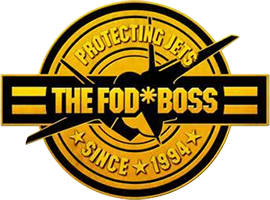To help you get the most out of your FOD*BOSS and to help amplify your FOD sweeping operations, we would like to share real-life experiences in using the FOD*BOSS to provide some simple tips and recommendations to help you maximise your FOD sweeping
The FOD*BOSS Airfield friction sweeper changed aviation tarmac cleaning forever in 1994 and has been protecting every major Air Force, Airport and Airline ever since.
To help you get the most out of your FOD*BOSS and to help amplify your FOD sweeping operations, we would like to share with you real-life experience in using the FOD*BOSS in the very demanding environment of military aviation, to provide some simple tips and recommendations that may help you in your own efforts and take full advantage of the FOD*BOSS Ultimate’s many benefits that make it the safest, most effective airfield sweeper, guaranteed.
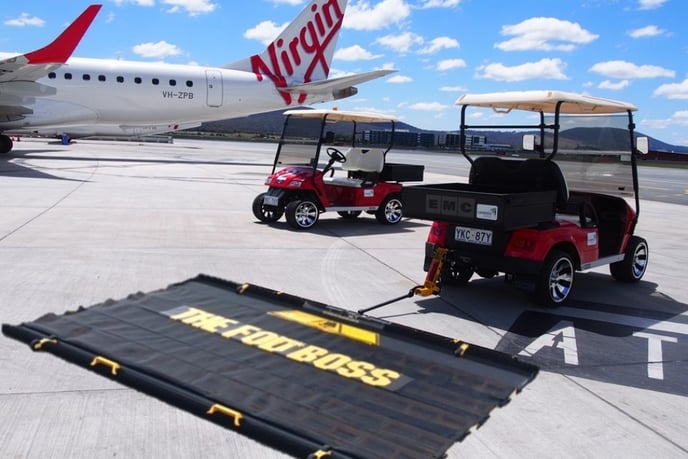 Before You Start
Before You Start
Inspecting Before Use:
Before you sign out your FOD*BOSS, ensure all towing hardware is in good working order:
- Check the steel cable Safety Lanyards and attached R- Clip locking pins to ensure they are all in place, secured, and have not become stretched or loose.
- Verify all cable crimp sleeves attaching safety lanyards to hardware are tight.
A few minutes are all that’s needed to carry, transport, and attach the equipment to your vehicle.
Once the FOD*BOSS mat is rolled out on the ground, give it a quick “once-over” to check the condition of the netting, bristles, scoops, and Velcro. Make sure the tracking wheels are rotating freely.
Safety wire, wire bristles from sweeper trucks, and medium-sized rocks may wedge inside the netting and become stuck.
Ensure all parts are sound and remove any previously captured FOD.
There’s no sense in taking it back onto the flight line.
Transporting Your FOD*BOSS
The FOD*BOSS is 8 feet (2.4 m) long. If you have a six-foot (1.8 m) pickup bed, I recommend carrying it with the raised end alongside the driver’s side of the cab. You can keep your eye on it that way in your side mirror. Any FOD that may have escaped your pre-ops inspection will tend to migrate down the mat and towards the bed instead of possibly bouncing out over or under the tailgate.
If you are driving slow and not going far you should be able to drive with the FOD*BOSS unsecured inside the truck bed.
Faster driving, frequent stops or a long drive dictate that you should transport the FOD*BOSS tied down or flat inside an eight-foot bed or van.
Consider purchasing a split-folding FOD*BOSS if you have less than an eight-foot truck bed. When broken down for storage the split-folding model is four feet long and can fit into minivans, back seats, and vehicle trunks. The convenience may be well worth the slightly higher cost.
Ensure that the truck bed is clean of FOD before you lay the FOD*BOSS in it or you may drag something out when you pull the FOD*BOSS off the tailgate.
Attaching the GroundForce™ Tow Hitch
Attaching the GroundForce Tow Hitch to your vehicle is a simple and straightforward procedure:
Ensure your vehicle has the proper trailer ball or pintle hook before you attempt to use the FOD*BOSS. If you have to modify your vehicle to tow the FOD*BOSS be sure you have the proper permission to do so.
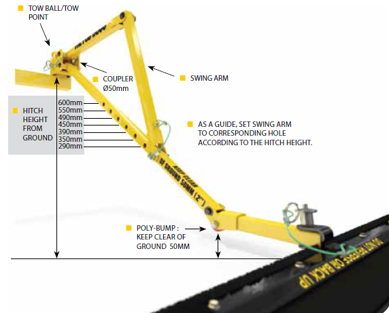
Get to know which of the cross-drilled holes in the Hitch is correct to use for the height adjustment needed on your towing vehicle(s). Ensure the bottom of the hitch adapter is four inches (50 mm) above the ground in accordance with the operating manual directions.
DO NOT OPERATE THE FOD*BOSS WITH THE LITTLE 4” (50 mm) (Poly-Bump) HITCH WHEEL ROLLING ON THE GROUND.
This is a fairly common mistake. There is a label on the hitch to remind you not to do this. Make sure all your personnel are aware of it or damage may result.
Getting Underway
Operating The FOD*BOSS
“I have found on our flight line that for average use, 30 miles per hour (50kph) is optimal. If you drive too slowly (< 3 mph / 5 kph) the contacted material will not receive the energy required to flip up into the hopper netting’s debris capture pockets. A little faster than a rapid walking pace is the minimum required speed. A slightly higher maximum speed (approx. 40 mph / 55 kph) may work better for use when there is a lot of water or sand present.”
-
Lower your side mirror enough to use it for keeping an eye on your FOD*BOSS.
-
Turning in a clockwise direction will allow you to spy any debris that may have been missed. (For right-drive vehicles, counter-clockwise).
-
Look behind you in your rear-view mirror as you straighten the wheels out to see if you missed anything during your turn and you went off track.
-
The FOD*BOSS can effectively sweep both smooth and grooved pavement surfaces. When sweeping any grooved pavement, it is a good idea to exit these areas onto the smooth pavement before stopping and emptying the sweeper.
-
The FOD*BOSS is very flexible under normal operating temperatures, but like any plastic, it will become more rigid in extreme cold. It is capable of operating at temperatures between minus 35 degrees Fahrenheit (-30 deg C) and 167 degrees Fahrenheit (75 deg C).
“I use my FOD*BOSS below zero degrees Fahrenheit (-17 Deg. C) at times when the mission priority dictates.”
-
The FOD*BOSS GroundForce Tow Hitch has been specially designed to allow operation in high-wind situations, including cross-winds. However, use caution and go a little slower than normal when sweeping in high winds.
-
“A favourite practice of mine is to completely sweep the parking spot an aircraft just taxied out of.” Think about it; the most FOD that is likely to be sitting in that spot, is lying there just after the aircraft has just been serviced. Not much vehicle traffic has come through there yet. Whatever may have been dropped or left behind by maintenance is waiting to migrate under human energy or weather at the first opportunity. It’s also waiting for the next jet to taxi in. Sweeping through these fresh parking spots ensures the FOD “Stops Here”.
Make The Sun & Rain Your Ally
“On sunny days I have found that the best times for cruising for FOD are early or late in the day when the sun casts a shadow on everything, including FOD. Driving towards the sun helps you see the shadows. Driving away from it highlights the vertical sides of small debris and makes it appear brighter than the horizontal surfaces it rests on.”
“I like rainy overcast days the best.” When nothing else works well, the FOD*BOSS is a great tool to use on the airfield. Overcast skies mean the debris on the shiny, wet paved surfaces will reflect themselves to you no matter which direction you’re driving. This makes everything look twice as tall as it really is and helps it to stand out.
A wonderful fact about a hard rain or a good long soaking drizzle is that the finer sand, stones, and small debris that is laying in the concrete joints is often washed, splashed, or floated up onto the flat concrete.
While the cracks are still filled with water is a great time to drag the FOD*BOSS over these areas to flush debris out.
“I have never seen more sand and the finer gravel on my airfield than during and immediately after a rain. It doesn’t stay visible for long though. As the joints dry out, tires and wind move it back into the cracks once again and out of sight. A dry ramp means the FOD is no longer mirrored to your eyes by the wet concrete and virtually disappears from sight almost immediately.”
Sweep your ramp when it’s good and wet and you’ll find that the wet FOD your eyes were seeing was no mirage. Use the drag marks left in the wet pavement to ensure you are overlapping the areas you really want to cover well.
“One more thing: Wear full coverage wet weather gear when you shake out the FOD*BOSS in rainy conditions. Otherwise, it’ll soak you better than a black lab can drench a duck hunter!”
After Your Sweep
Emptying Your FOD*BOSS
Make every attempt to keep the load light inside the mat. This accomplishes several things: First, the hoppers can easily carry it all. Second, the more you are carrying, the more pressure you place on the underside of the mat. Lastly, you may find some objects of interest that you wouldn’t see if it were buried in debris. Like an important part that fell off an aircraft!
-
When you shake out the mat, grab the two handles and lift the sweeper to waist height. Then using a pulsing motion that makes the sweeper move up and down, shake the FOD out.
-
Choose an out-of-the-way spot to shake it out if possible.
-
Be sure you have a good broom, brush, and dustpan with you to pick it all up.
-
Shake it out on the leeward side of a taxiway so that if it's windy, dust and sand blow onto the grass instead of back out onto a taxiway or parking area.
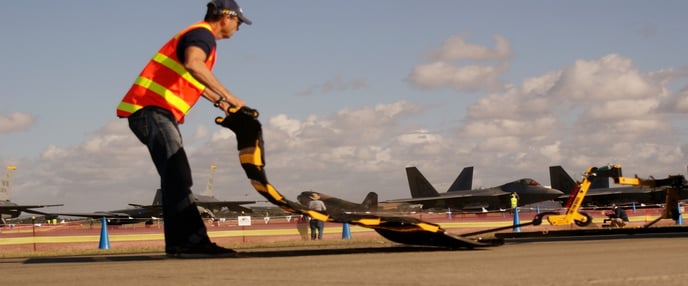
-
Move the mat as far to one side or the other as you can without disconnecting the mat from the hitch so you can broom everything up quickly and keep going.
-
Check the tow vehicle’s bumper and top of the mat for FOD that may have flipped up there when you gave your mat a good shake.
-
If you plan to continue using the FOD*BOSS, drive over the spot where you just emptied it out to ensure you didn’t leave anything behind. Cover a larger area than where the mat was shaken out by making a couple of passes off-centre.
Reminder: Wear full coverage wet weather gear when you shake out the FOD*BOSS in rainy conditions.
“I like to carry a large 5-gallon bucket with a snap-on lid. I keep it secured in my truck with the dustpan and brush inside it. On almost any given day I fill the bucket to overflowing and sometimes as much as four times if I drag the roads feeding into the airfield. This equates to about 150 pounds of FOD in several hours. These rougher roads probably weren’t what the designers had in mind but I like to augment the street sweepers in those locations before these same stones and debris can migrate via tires any farther onto my airfield.”
Storing Your FOD*BOSS
When it’s time to put your FOD*BOSS away and you’ve shaken it out a final time, disconnect the tow hitch from the vehicle and put it away in its case.
-
Lay out the bag on the trailing edge of the sweeper and tuck its edge about 3 inches (8 cm) underneath, or enough so that the wind can’t blow it away. I recommend laying the bag down alongside it with the FOD*BOSS label towards the truck. You’ll know which way to open it the next time you go to use it.
-
Roll up the mat starting with the tongue end first. For some reason, it rolls up smaller and tighter from the front end.
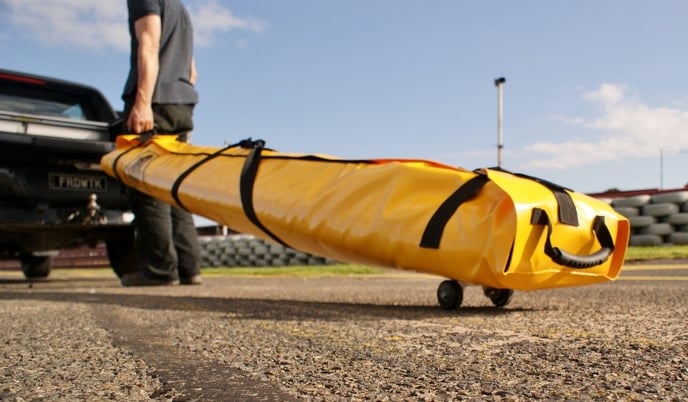
-
Lift the FOD*BOSS up on the side nearest your feet and let the rear wheels roll onto the centre of the mat. Snap the clasps closed and then pull on the straps to snugly pull it down tight. Tight is best to keep any leftover FOD possibly stuck inside, from working its way out of the bag during transport.
-
Use the roller bag (which has wheels) to move the FOD*BOSS to your vehicle. Lift the roller bag by the handles or by the tie-down straps onto your vehicle for transport.
-
If the FOD*BOSS is wet you need to have a drying-out place so it won’t get mildew growing in it. Never store it away wet unless you know you will be using it again in a very short period of time. Especially in the summer heat, it could stink like mildew for weeks!
-
It is good to take your FOD*BOSS to the wash rack from time-to-time also. Crud can build up in the bristles and a good bath just makes it work at its best. If you are going to spray it with a cleaner, use organic-based types only. Never use a petroleum or solvent-based degreaser.
-
Always store your FOD*BOSS flat and above freezing temperatures. Keep it in a place where it is safe from being walked on.
HINT: Make sure everyone who may have access to the FOD*BOSS knows how important it is and what it is used for.
Final Word
“Over the years, I’ve learned a lot about the niches that animals fill in nature. A niche is the place, employment or activity for which a person or thing best fits, or the ecological role of an organism in a community. Animals always fit into a “niche.” While two species may look similar i.e., lions and cheetahs, they don’t usually compete head to head for the same survival needs.”
The same applies to FOD sweeping: nearly every airfield has a vacuum sweeper truck, or at least access to one. These trucks are comparatively large, move very slowly and some models don’t even pick up FOD particularly well. Your FOD*BOSS should compensate for this, while not necessarily competing directly with the vacuum sweeper. While it is more than capable of sweeping the entire airfield, the FOD*BOSS can be a complementary tool to be used as appropriate. “For example, if I had jet-fighters I would FOD*BOSS the taxi routes and aprons as much as possible prior to taxiing jets, but I wouldn’t try to clean up the entire airfield every day.”
Based on the niche concept mentioned earlier, your smaller, faster, and water-loving FOD*BOSS can go places the big sweepers can’t: between parked aircraft, along taxiway shoulders and entry control points, slaloming through taxiway lights, and cleaning up the parking ramp like “Johnny-On-The-Spot” are great ways the FOD*BOSS can fit it’s newly created airfield FOD niche.
“Lastly, your FOD*BOSS has a life expectancy. Sweep often and empty often to prolong its life. Be sure you have its next replacement mat on hand before the current one is worn out, so there is no gap in your operations. I personally recommend having a FOD*BOSS with you whenever and wherever possible. If you’re the FOD Guy, you’ll appreciate its presence more than anyone else.”
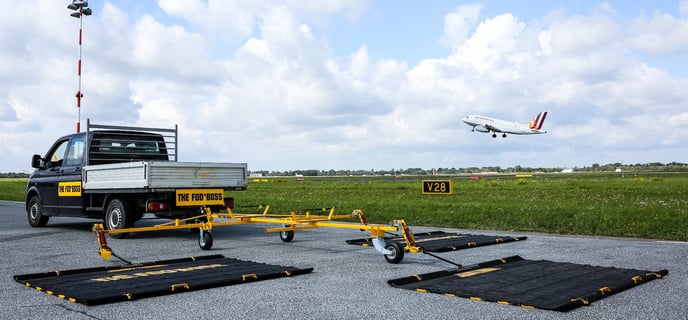
Thank you for your interest in our FOD*BOSS® Airfield Sweeping System.
Our FOD*BOSS friction sweeper changed aviation tarmac cleaning forever in 1994 and has been protecting every major Air Force, Airport, and Airline ever since.
The FOD*BOSS Ultimate’s many benefits make it the safest, most effective airfield sweeper, guaranteed.
The FOD*BOSS is fully equipped with our exclusive and unique critical safety features that are the secret behind its unbeatable performance and essential to your successful FOD removal operations.
These are unavailable with any other sweeper.
Don’t take our word for it, see what our clients are saying on our website confirming our system is truly exceptional.
Aerosweep would like to sincerely thank the author of these tips and recommendations for their insights and guidance for the purpose of increasing FOD awareness and aviation safety.
